Article begins
“As a boy she is fine.”
Credit:
Sally Campbell Galman
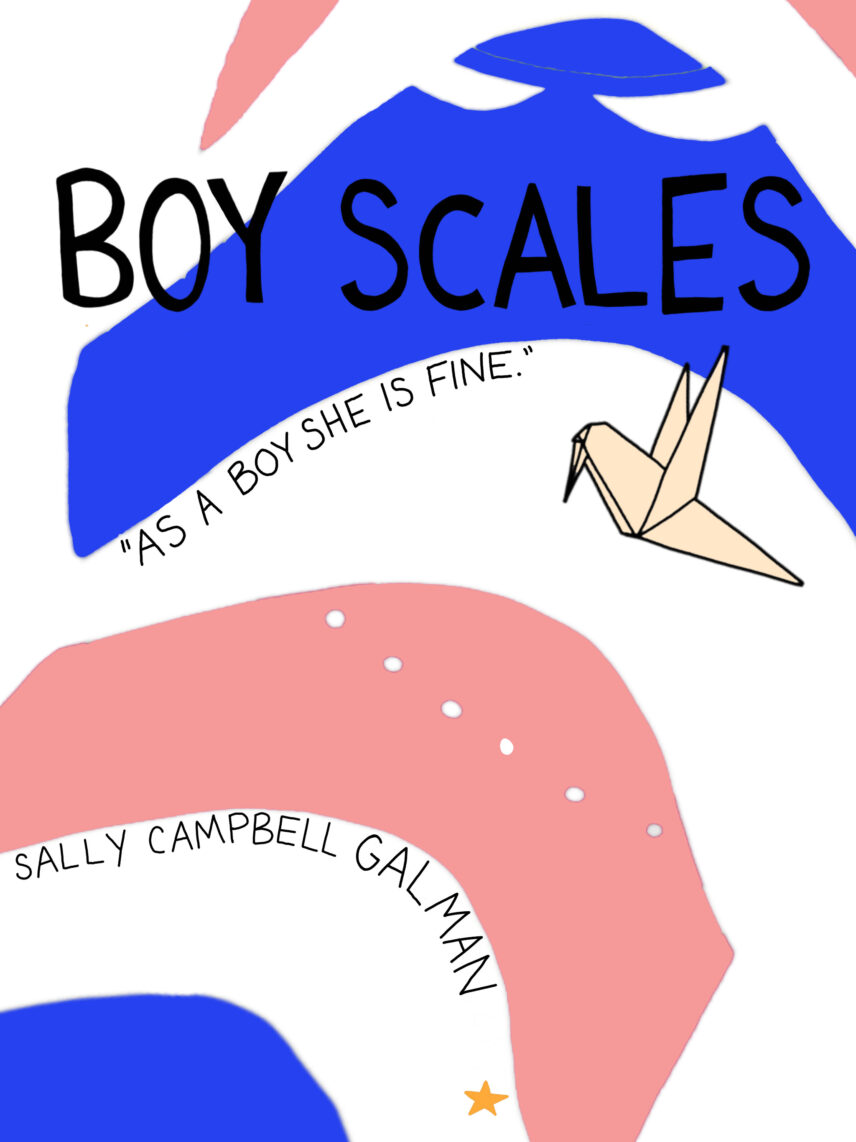
Image description: Blue and pink cutouts line the background of the image and an origami bird floats below the title, “Boy Scales.” Below the title are a subtitle (“As a boy she is fine.”) and author name (Sally Campbell Galman).
Credit:
Sally Campbell Galman
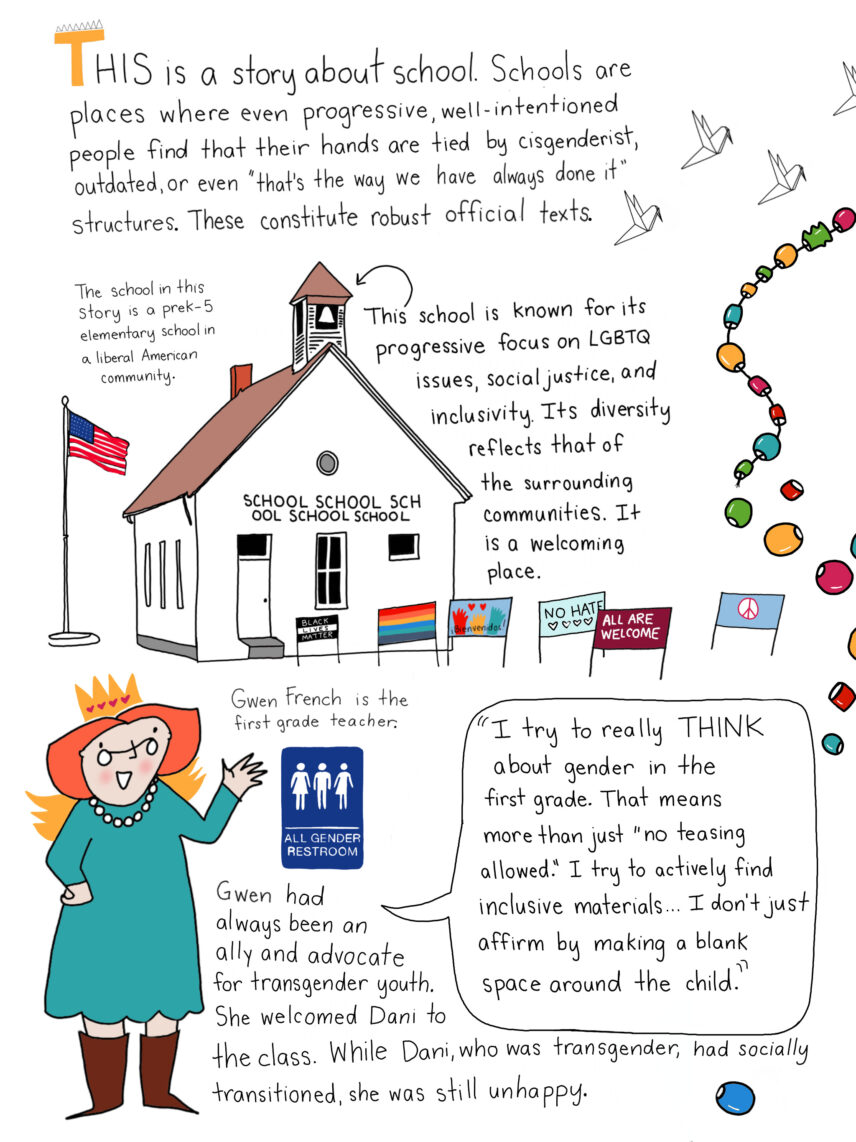
Image description: The comic page shows a school house with a US flag flying outside of it and signs in the front with various designs such as a rainbow and a peace sign, as well as some with the phrases “Black Lives Matter,” “No Hate,” and “All are welcome.” A woman with brown boots, a green dress, glasses, and red hair waves and smiles. A stylized pair of golden wings are visible behind her and a crown with hearts sits on her head—this is Gwen French. Beside her is the sign for an all gender restroom. Interwoven throughout are beads, both on a string and not.
Narrative text on the panel reads: “This is a story about school. Schools are places where even progressive, well-intentioned people find that their hands are tied by cisgenderist, outdated, or even “that’s the way we have always done it” structures. These constitute robust official texts. The school in this story is a pre-K-5 elementary school in a liberal American community. This school is known for its progressive focus on LGBTQ issues, social justice, and inclusivity. Its diversity reflects that of the surrounding communities. It is a welcoming place. Gwen French is the first-grade teacher. Gwen had always been an ally and advocate for transgender youth. She welcomed Dani to the class. While Dani, who was transgender, had socially transitioned, she was still unhappy.”
In a speech bubble, Gwen says “I try to really THINK about gender in the first grade. That means more than just “no teasing allowed.” I try to actively find inclusive materials… I don’t just affirm by making a blank space around the child. “
Narrative text on the panel reads: “This is a story about school. Schools are places where even progressive, well-intentioned people find that their hands are tied by cisgenderist, outdated, or even “that’s the way we have always done it” structures. These constitute robust official texts. The school in this story is a pre-K-5 elementary school in a liberal American community. This school is known for its progressive focus on LGBTQ issues, social justice, and inclusivity. Its diversity reflects that of the surrounding communities. It is a welcoming place. Gwen French is the first-grade teacher. Gwen had always been an ally and advocate for transgender youth. She welcomed Dani to the class. While Dani, who was transgender, had socially transitioned, she was still unhappy.”
In a speech bubble, Gwen says “I try to really THINK about gender in the first grade. That means more than just “no teasing allowed.” I try to actively find inclusive materials… I don’t just affirm by making a blank space around the child. “
Credit:
Sally Campbell Galman
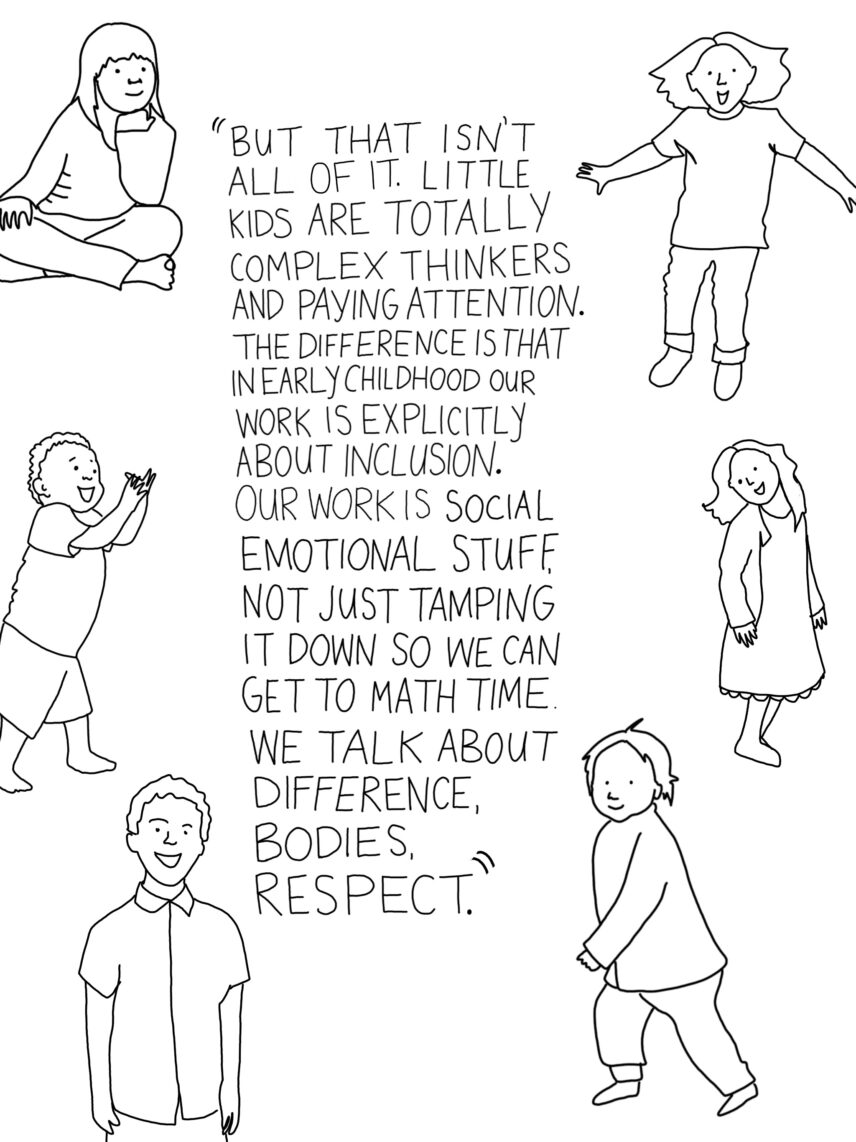
Image description: A quote from the first-grade teacher is surrounded by various black and white illustrations of children. The quote reads “But that isn’t all of it. Little kids are totally complex thinkers and paying attention. The difference is that in early childhood our work is explicitly about inclusion. Our work is social emotional stuff, not just tamping it down so we can get to math time. We talk about difference, bodies, respect.”
Credit:
Sally Campbell Galman
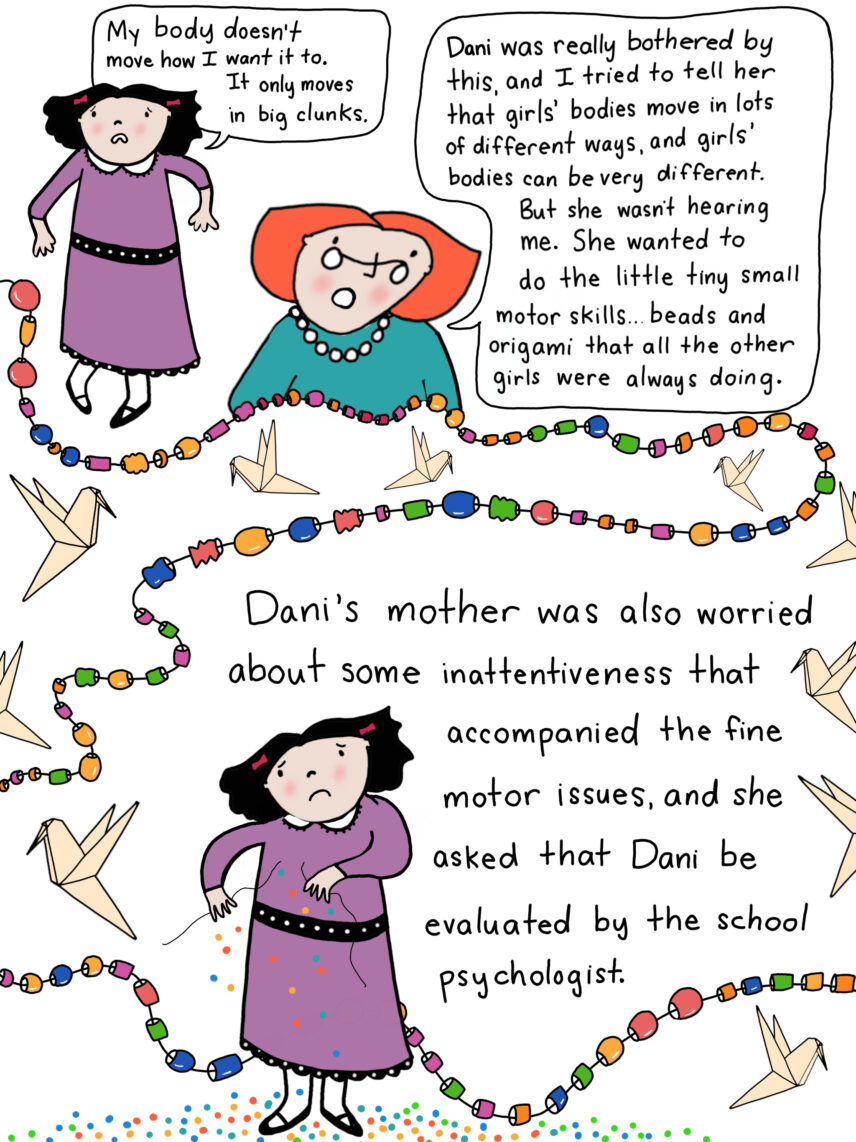
Image description: Origami birds and strings of beads are woven throughout the illustration. At the top of the page, a black-haired girl, Dani, wears and purple dress, looking distressed and saying “My body doesn’t move how I want it to. It only moves in big clunks.” Gwen French speaks as well, noting that “Dani was really bothered by this, and I tried to tell her that girls’ bodies move in lots of different ways, and girls’ bodies can be very different. But she wasn’t hearing me. She wanted to do the little tiny small motor skills… beads and origami that all the other girls were always doing.
Dani appears on the page again, frowning deeply, and she holds two pieces of string with beads falling off of them and scattering around her feet. The text beside her reads: “Dani’s mother was also worried about some inattentiveness that accompanied the fine motor issues, and she asked that Dani be evaluated by the school psychologist.
Dani appears on the page again, frowning deeply, and she holds two pieces of string with beads falling off of them and scattering around her feet. The text beside her reads: “Dani’s mother was also worried about some inattentiveness that accompanied the fine motor issues, and she asked that Dani be evaluated by the school psychologist.
Credit:
Sally Campbell Galman
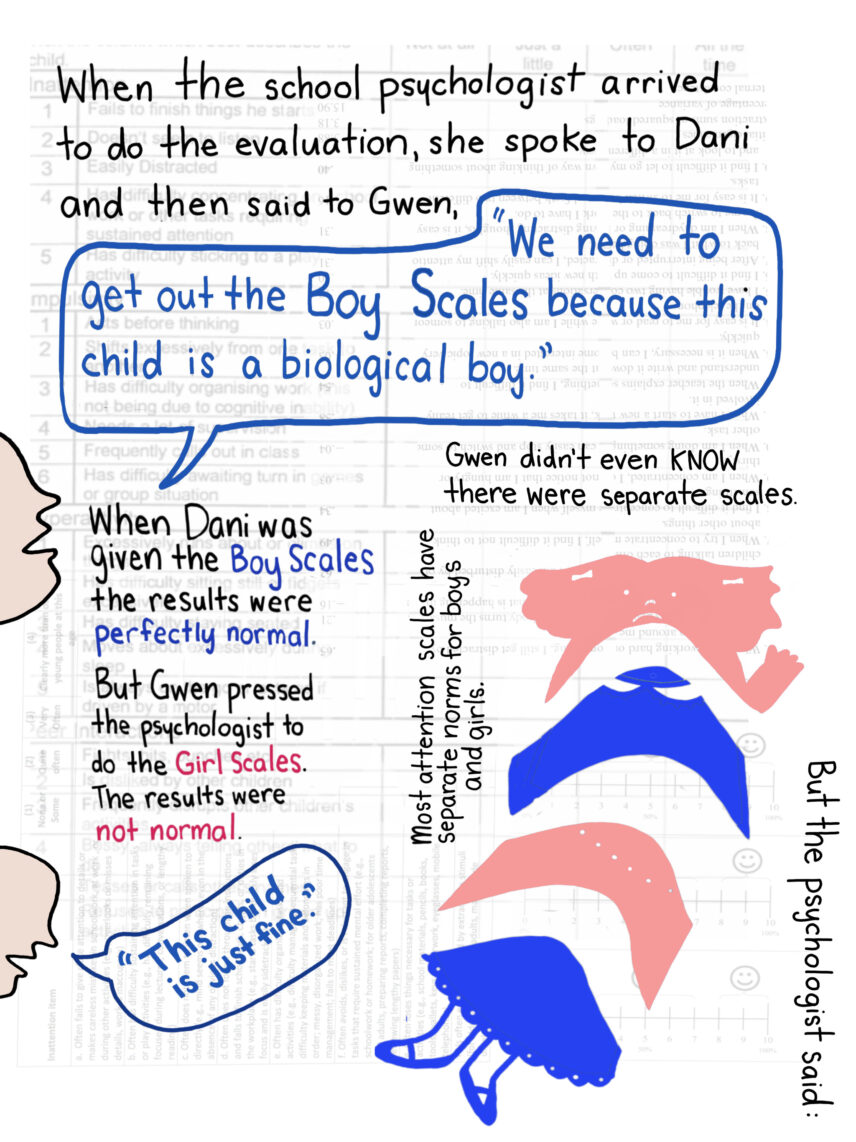
Image description: The text on the page begins “When the school psychologist arrived to do the evaluation, she spoke to Dani and then said to Gwen, ‘We need to get out the Boy Scales because this child is a biological boy.’ Gwen didn’t even KNOW there were separate scales. Most attention scales have separate norms for boys and girls. When Dani was given the Boy Scales the results were perfectly normal. But Gwen pressed the psychologist to do the Girl Scales. The results were no normal.”
A face appears below this text in profile, representing the school psychologist, and says “This child is just fine.”
Beside the psychologist is an illustration of a child who looks similar to Dani from the other page, except she is illustrated in four different pieces, as if a doll made of cut-outs. The four pieces alternate between pink and blue. The text beside this illustration reads “But the psychologist said:” and the quote from the psychologist appears in the next image.
A face appears below this text in profile, representing the school psychologist, and says “This child is just fine.”
Beside the psychologist is an illustration of a child who looks similar to Dani from the other page, except she is illustrated in four different pieces, as if a doll made of cut-outs. The four pieces alternate between pink and blue. The text beside this illustration reads “But the psychologist said:” and the quote from the psychologist appears in the next image.
Credit:
Sally Campbell Galman
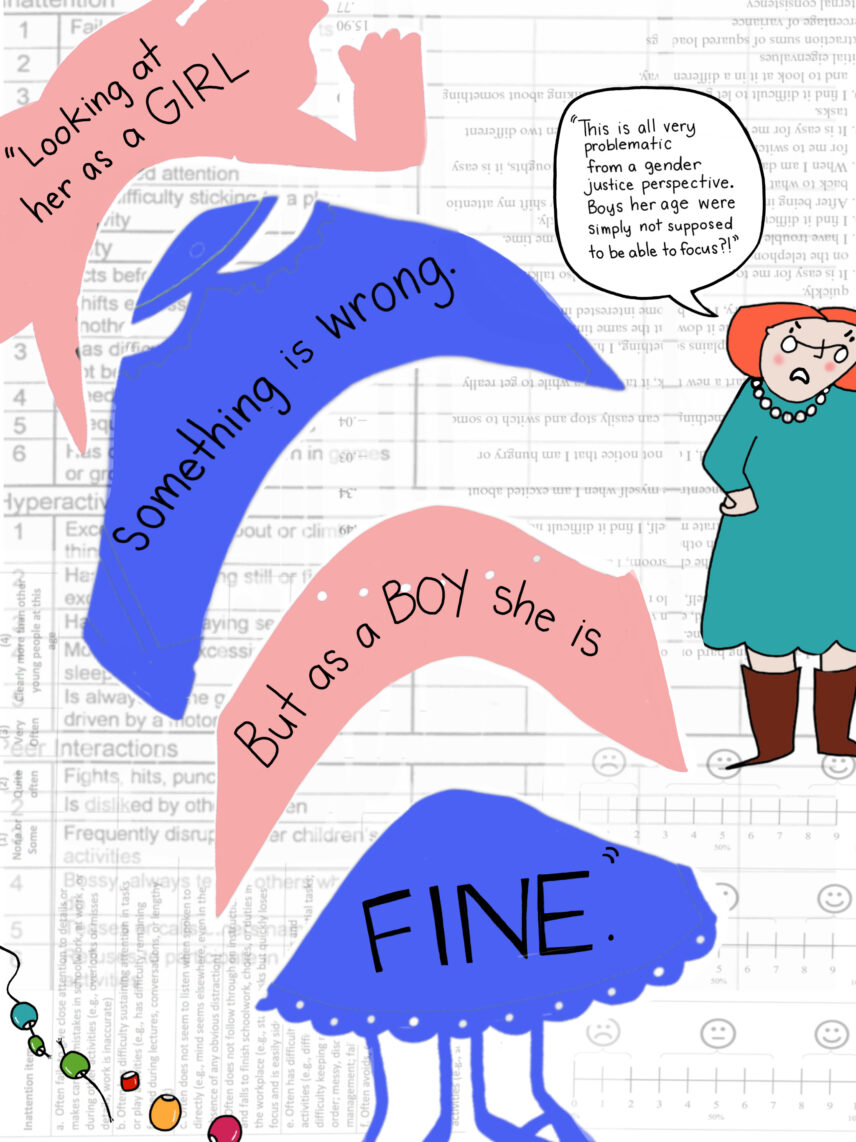
Image description: The pink and blue cut-outs from the previous image reappear, larger this time, and across them the school psychologist’s quoe is written “Looking at her as a GIRL something is wrong. But as a BOY she is FINE.”
A drawing of Gwen French stands to the side looking angry and speaking. “This is all very problematic from a gender justice perspective. Boys her age were simply not supposed to be able to focus?!”
A drawing of Gwen French stands to the side looking angry and speaking. “This is all very problematic from a gender justice perspective. Boys her age were simply not supposed to be able to focus?!”
Credit:
Sally Campbell Galman
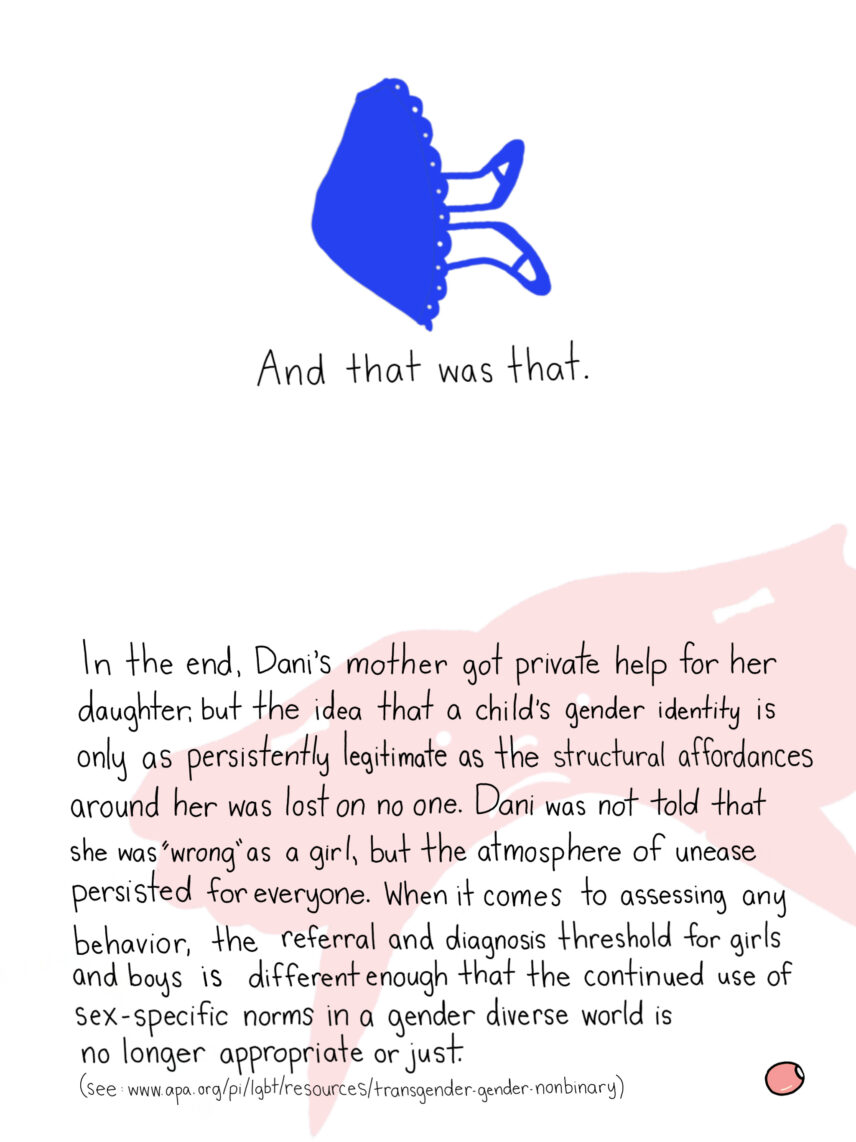
Image description: Blue-colored illustration of the bottom half of an individual (a skirt with legs poking out beneath) appears at the top of the page with the words “And that was that” below it.
At the bottom of the page, more text follows. “In the end, Dani’s mother got private help for her daughter, but the idea that a child’s gender identity is only as persistently legitimate as the structural affordances around her was lost on no one. Dani was not told that she was ‘wrong’ as a girl, but the atmosphere of unease persisted for everyone. When it comes to assessing any behavior, the referral and diagnosis threshold for girls and boys is different enough that the continued use of sex-specific norms in a gender diverse world is no longer appropriate or just. (See: www.apa.org/pi/lgbt/resources/transgender-gender-nonbinary)
At the bottom of the page, more text follows. “In the end, Dani’s mother got private help for her daughter, but the idea that a child’s gender identity is only as persistently legitimate as the structural affordances around her was lost on no one. Dani was not told that she was ‘wrong’ as a girl, but the atmosphere of unease persisted for everyone. When it comes to assessing any behavior, the referral and diagnosis threshold for girls and boys is different enough that the continued use of sex-specific norms in a gender diverse world is no longer appropriate or just. (See: www.apa.org/pi/lgbt/resources/transgender-gender-nonbinary)
Credit:
Sally Campbell Galman
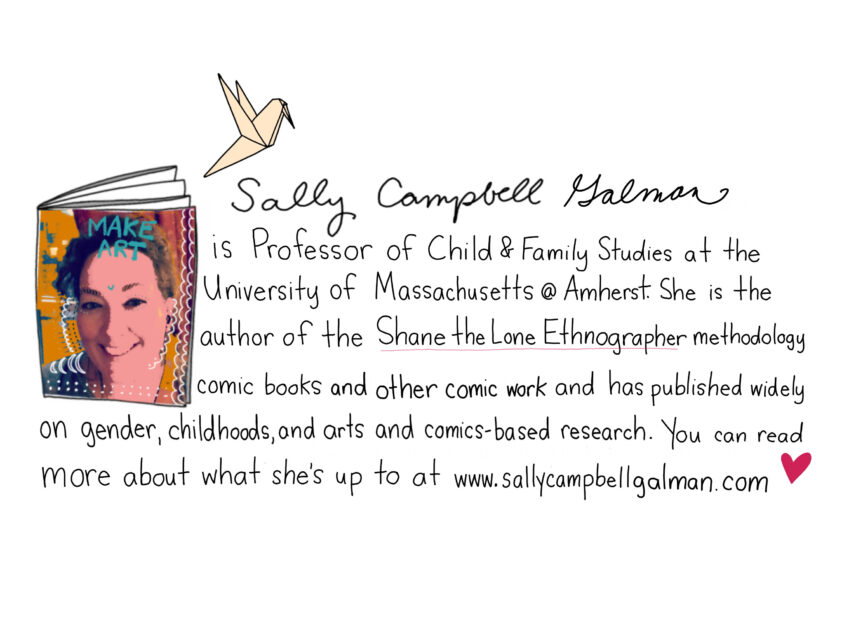
Image description: A booklet bears a woman’s face with the words “Make Art” on it. An origami bird floats above a hand-written author biography. The biography reads as follows: Sally Campbell Galman is professor of child and family studies at the University of Massachusetts @ Amherst. She is the author of the Shane the Lone Ethnographer methodology comic books and other comic work and has published widely on gender, childhoods, and arts and comics-based research. You can read more about what she’s up to at www.sallycampbellgalman.com.

